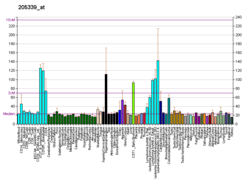STIL
SCL-interrupting locus protein is a protein that in humans is encoded by the STIL gene.[5][6]
This gene encodes a cytoplasmic protein implicated in regulation of the mitotic spindle checkpoint, a regulatory pathway that monitors chromosome segregation during cell division to ensure the proper distribution of chromosomes to daughter cells. The protein is phosphorylated in mitosis and in response to activation of the spindle checkpoint, and disappears when cells transition to G1 phase. It interacts with a mitotic regulator, and its expression is required to efficiently activate the spindle checkpoint. It is proposed to regulate Cdc2 kinase activity during spindle checkpoint arrest. Chromosomal deletions that fuse this gene and the adjacent locus commonly occur in T cell leukemias, and are thought to arise through illegitimate recombination events. Multiple transcript variants encoding different isoforms have been found for this gene.[6]
Homozygous mutations in the STIL gene cause primary microcephaly (small brain) in humans.
References
- 1 2 3 GRCh38: Ensembl release 89: ENSG00000123473 - Ensembl, May 2017
- 1 2 3 GRCm38: Ensembl release 89: ENSMUSG00000028718 - Ensembl, May 2017
- ↑ "Human PubMed Reference:".
- ↑ "Mouse PubMed Reference:".
- ↑ Brown L, Cheng JT, Chen Q, Siciliano MJ, Crist W, Buchanan G, Baer R (Nov 1990). "Site-specific recombination of the tal-1 gene is a common occurrence in human T cell leukemia". EMBO J. 9 (10): 3343–51. PMC 552072. PMID 2209547.
- 1 2 "Entrez Gene: STIL SCL/TAL1 interrupting locus".
Further reading
- Aplan PD, Lombardi DP, Reaman GH, et al. (1992). "Involvement of the putative hematopoietic transcription factor SCL in T-cell acute lymphoblastic leukemia". Blood. 79 (5): 1327–33. PMID 1311214.
- Aplan PD, Lombardi DP, Kirsch IR (1991). "Structural characterization of SIL, a gene frequently disrupted in T-cell acute lymphoblastic leukemia". Mol. Cell. Biol. 11 (11): 5462–9. PMC 361915. PMID 1922059.
- Jonsson OG, Kitchens RL, Baer RJ, et al. (1991). "Rearrangements of the tal-1 locus as clonal markers for T cell acute lymphoblastic leukemia". J. Clin. Invest. 87 (6): 2029–35. doi:10.1172/JCI115232. PMC 296958. PMID 2040693.
- Aplan PD, Lombardi DP, Ginsberg AM, et al. (1991). "Disruption of the human SCL locus by "illegitimate" V-(D)-J recombinase activity". Science. 250 (4986): 1426–9. doi:10.1126/science.2255914. PMID 2255914.
- Kikuchi A, Hayashi Y, Kobayashi S, et al. (1993). "Clinical significance of TAL1 gene alteration in childhood T-cell acute lymphoblastic leukemia and lymphoma". Leukemia. 7 (7): 933–8. PMID 8321044.
- Collazo-Garcia N, Scherer P, Aplan PD (1997). "Cloning and characterization of a murine SIL gene". Genomics. 30 (3): 506–13. doi:10.1006/geno.1995.1271. PMID 8825637.
- Izraeli S, Colaizzo-Anas T, Bertness VL, et al. (1997). "Expression of the SIL gene is correlated with growth induction and cellular proliferation". Cell Growth Differ. 8 (11): 1171–9. PMID 9372240.
- Göttgens B, Barton LM, Gilbert JG, et al. (2000). "Analysis of vertebrate SCL loci identifies conserved enhancers". Nat. Biotechnol. 18 (2): 181–6. doi:10.1038/72635. PMID 10657125.
- Raghavan SC, Kirsch IR, Lieber MR (2001). "Analysis of the V(D)J recombination efficiency at lymphoid chromosomal translocation breakpoints". J. Biol. Chem. 276 (31): 29126–33. doi:10.1074/jbc.M103797200. PMID 11390401.
- Carlotti E, Pettenella F, Amaru R, et al. (2002). "Molecular characterization of a new recombination of the SIL/TAL-1 locus in a child with T-cell acute lymphoblastic leukaemia". Br. J. Haematol. 118 (4): 1011–8. doi:10.1046/j.1365-2141.2002.03747.x. PMID 12199779.
- Karkera JD, Izraeli S, Roessler E, et al. (2003). "The genomic structure, chromosomal localization, and analysis of SIL as a candidate gene for holoprosencephaly". Cytogenet. Genome Res. 97 (1–2): 62–7. doi:10.1159/000064057. PMID 12438740.
- Strausberg RL, Feingold EA, Grouse LH, et al. (2003). "Generation and initial analysis of more than 15,000 full-length human and mouse cDNA sequences". Proc. Natl. Acad. Sci. U.S.A. 99 (26): 16899–903. doi:10.1073/pnas.242603899. PMC 139241. PMID 12477932.
- Colaizzo-Anas T, Aplan PD (2003). "Cloning and characterization of the SIL promoter". Biochim. Biophys. Acta. 1625 (2): 207–13. doi:10.1016/S0167-4781(02)00597-3. PMID 12531481.
- Curry JD, Smith MT (2003). "Measurement of SIL-TAL1 fusion gene transcripts associated with human T-cell lymphocytic leukemia by real-time reverse transcriptase-PCR". Leuk. Res. 27 (7): 575–82. doi:10.1016/S0145-2126(02)00260-6. PMID 12681356.
- Cavé H, Suciu S, Preudhomme C, et al. (2004). "Clinical significance of HOX11L2 expression linked to t(5;14)(q35;q32), of HOX11 expression, and of SIL-TAL fusion in childhood T-cell malignancies: results of EORTC studies 58881 and 58951". Blood. 103 (2): 442–50. doi:10.1182/blood-2003-05-1495. PMID 14504110.
- Erez A, Perelman M, Hewitt SM, et al. (2004). "Sil overexpression in lung cancer characterizes tumors with increased mitotic activity". Oncogene. 23 (31): 5371–7. doi:10.1038/sj.onc.1207685. PMID 15107824.
- Gerhard DS, Wagner L, Feingold EA, et al. (2004). "The Status, Quality, and Expansion of the NIH Full-Length cDNA Project: The Mammalian Gene Collection (MGC)". Genome Res. 14 (10B): 2121–7. doi:10.1101/gr.2596504. PMC 528928. PMID 15489334.
- Campaner S, Kaldis P, Izraeli S, Kirsch IR (2005). "Sil Phosphorylation in a Pin1 Binding Domain Affects the Duration of the Spindle Checkpoint". Mol. Cell. Biol. 25 (15): 6660–72. doi:10.1128/MCB.25.15.6660-6672.2005. PMC 1190358. PMID 16024801.
- Kimura K, Wakamatsu A, Suzuki Y, et al. (2006). "Diversification of transcriptional modulation: Large-scale identification and characterization of putative alternative promoters of human genes". Genome Res. 16 (1): 55–65. doi:10.1101/gr.4039406. PMC 1356129. PMID 16344560.
Kumar A, Girimaji SC, Duvvari MR, Blanton SH (2009): Mutations in STIL,
encoding a pericentriolar and centrosomal protein, cause primary
microcephaly. American Journal of Human Genetics 84:286-290.




